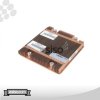SupraSPL
Well-Known Member
Ya it has crossed my mind that maybe it was something else that caused it. Maybe I hooked up the COB to the HLG-180H-C1050B while the switch was on and it got damaged without my noticing. Also, the actual Tc may have been as high as 85C, but still should have been OK with that heat at 1050mA.






